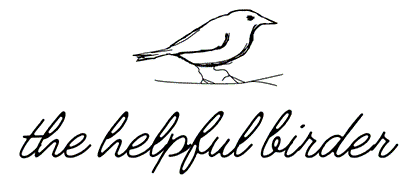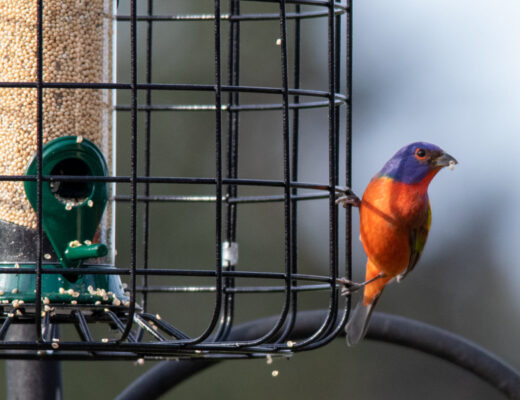Watching birds visit your backyard can be a source of joy and wonder. If you’re a homeowner who loves the company of these feathered friends, creating a welcoming bird feeding station in your yard is a fulfilling endeavor.
In this article, we’ll provide straightforward ideas and tips to help you attract more birds to your outdoor space. From choosing the right location to selecting feeders and bird-friendly plants, we’ll guide you in creating a bird haven just outside your window. Let’s embark on a journey where every mealtime becomes a symphony of chirps and tweets – welcome to the world of backyard bird feeding stations.
Benefits of Bird Feeding Stations
Bird feeding stations offer more than just the pleasure of birdwatching; they play a vital role in nurturing local wildlife and contributing to the ecological balance of your area. If you want to view birds in your back yard, creating a bird feeding station is the best way to proceed.
Here are some key benefits of a bird feeding station:
- Biodiversity Enhancement: Bird feeders attract a variety of bird species, which can increase the overall biodiversity of your yard. This diversity can have positive effects on the local ecosystem by supporting different bird populations.
- Educational Opportunities: Bird feeding stations provide a unique opportunity for homeowners and their families to learn about the different bird species that visit. It’s a chance to observe their behaviors, feeding habits, and migratory patterns up close.
- Stress Reduction: Bird watching is a calming and meditative activity that can help reduce stress and anxiety. Just a few minutes spent observing birds in your backyard can have a soothing effect on your mind.
- Pollination and Pest Control: Birds play a role in pollination and insect control, which can benefit your garden and plants. They help keep insect populations in check by consuming many common garden pests.
- Connection to Nature: A well-designed bird feeding station can foster a deeper connection to nature, encouraging homeowners to appreciate and protect the environment.
In the sections that follow, we’ll explore the practical aspects of setting up a successful bird feeding station, from choosing the right location to selecting the right feeders and foods to attract a wide variety of birds to your yard.
Choosing the Right Location
The success of your backyard bird feeding station hinges on selecting the perfect location. Birds, like any creatures, prioritize safety, accessibility, and comfort when it comes to dining. Here’s how to pick the right spot:
- Safety First: Birds are cautious by nature. Ensure the location is safe from potential predators like cats. Consider placing feeders at least five to six feet from dense shrubs or hiding spots where cats might lurk.
- Visibility Matters: To enjoy the avian visitors, position your feeding station near a window or a comfortable viewing spot in your home. This provides an unobstructed view while minimizing disturbances to the birds.
- Easy Access: Birds appreciate easy access to food and fresh water. Make sure the feeding station is within flying distance from nearby perches and trees, allowing them to make quick getaways if necessary.
- Shelter and Perching Areas: While open spaces are great for visibility, having nearby shelter like bushes or trees can provide resting spots for birds in between feedings. Consider including perches or natural cover in your setup.
- Keep it Clean: Choose a location that’s easy to maintain. Fallen seeds and bird droppings can accumulate, so a location with minimal impact on your outdoor living space will make cleanup more manageable.
- Sun and Shade Balance: Depending on the climate in your area, consider providing some shade during hot summers and ensuring the location gets adequate sunlight in colder months to prevent feed from spoiling.
Taking these factors into account when selecting your feeding station’s location will set the stage for a welcoming and safe dining experience for your feathered guests.
Types of Bird Feeders
The heart of any bird feeding station lies in its feeders. These essential fixtures come in various styles, each catering to specific bird species and feeding preferences. Having several kinds of feeders is a good idea, as it will generally attract more birds. Here are some of the best bird feeders to consider:
Platform Feeders
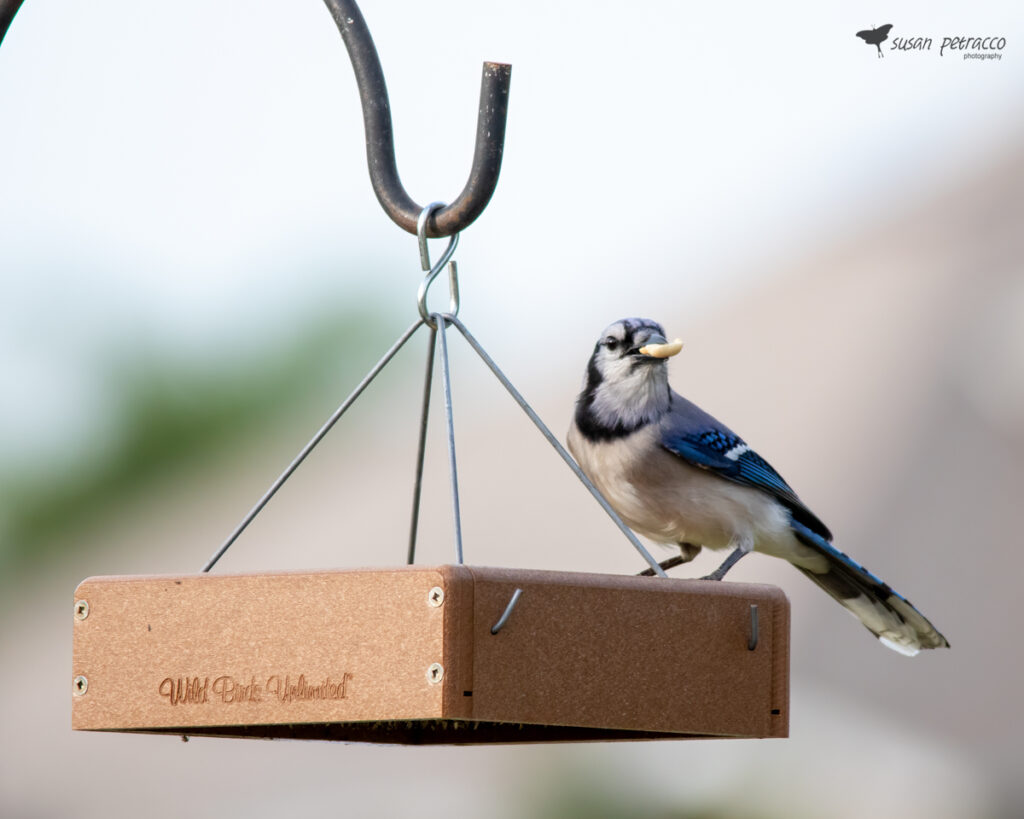
These flat, open trays are a versatile choice, accommodating a variety of seed types. They are ideal for ground-feeding birds like sparrows, juncos, and mourning doves, but many other species use them as well. Their simple design generally makes them less expensive and easier to clean than many other kinds of feeders. (Here is a great platform feeder for sale on Amazon. The one I have shown above is from Wild Birds Unlimited.)
Hopper Feeders
Hopper feeders are house-shaped and feature a container for holding seeds. They are great for attracting larger birds like cardinals and chickadees. Some models are squirrel-resistant. (Explore hopper feeders on Amazon.)
Tube Feeders
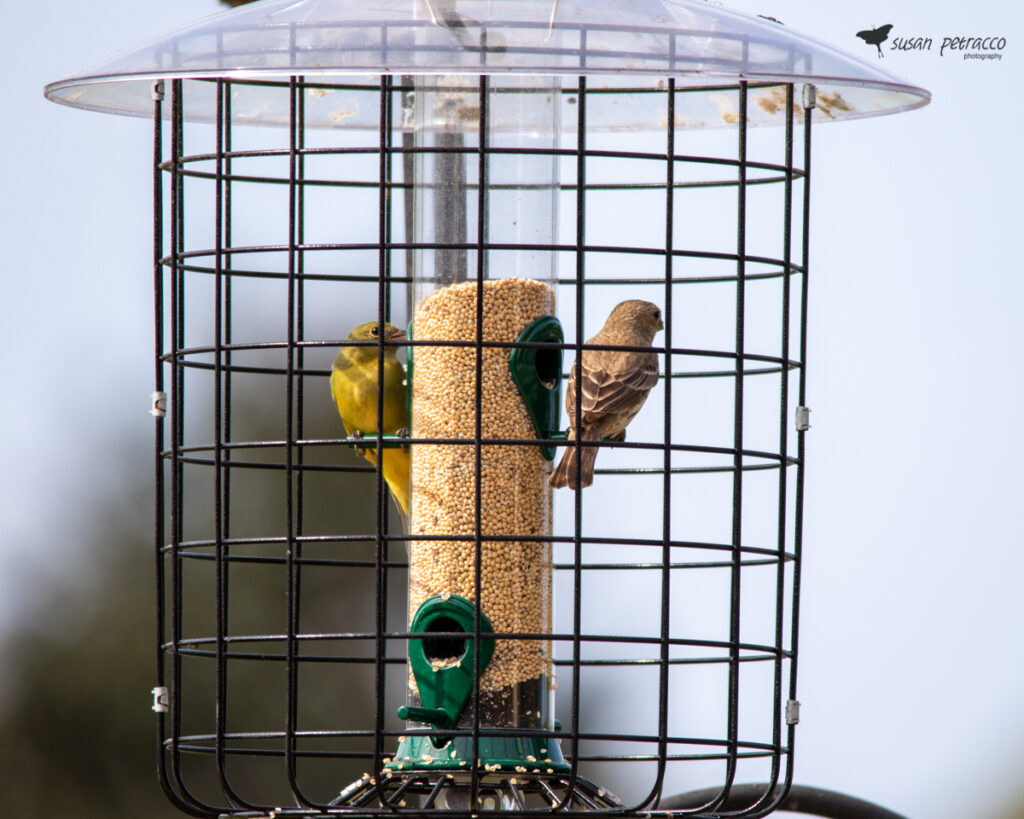
Tube feeders have multiple ports for birds to access seeds while keeping them protected from the elements. These are perfect for attracting finches, nuthatches, and smaller songbirds. I love my tube feeder from Wild Birds Unlimited, but there are lots of options on Amazon as well.
Some tube feeders have a cage around them that prevents larger birds and predators from getting inside. I use this kind for white millet for my painted buntings. It helps keep them safe, and it keeps out the grackles that will eat up all my birdseed budget in less than an hour! But there are lots of other tube feeders without a cage, and I use one of those as well.
Suet Feeders
Suet feeders hold blocks of high-energy suet cakes, which are especially appealing to woodpeckers, wrens, and insect-eating birds. The most basic suet feeder, also known as a suet cage, is very inexpensive, and you can get them at Walmart as well as on Amazon. You can also get fancier ones if you prefer the loop.
Nyjer (Thistle) Feeders
Designed for tiny seeds like Nyjer (thistle), these feeders attract finches, siskins, and goldfinches. They often feature small, thin feeding ports. Or you can get a cloth-based on known as a Nyjer sock. Both are a great way to feed the species that love Nyjer seeds. (By the way, it’s pronounced “knee zhair”, like the French pronunciation of the African country Niger.)
Nectar Feeders
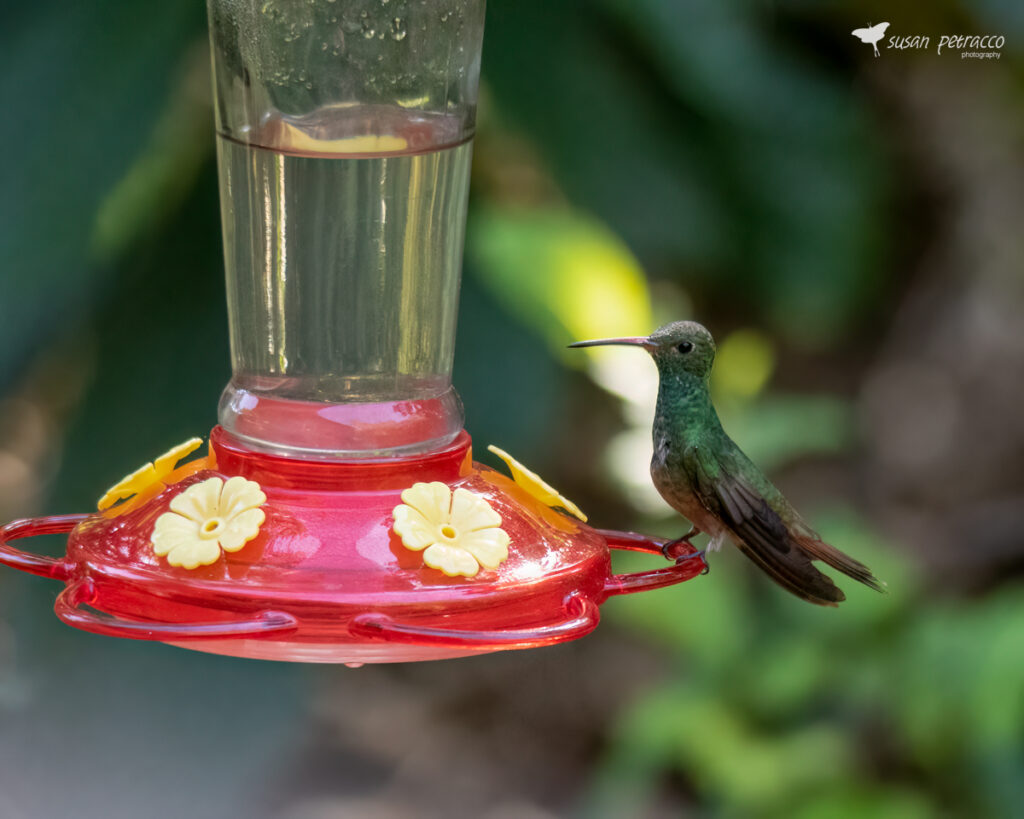
If you’re interested in attracting hummingbirds, nectar feeders with bright colors and special feeding ports are essential. Nectar solutions mimic the flower nectar these birds feed on. You can even make your own hummingbird nectar to save money.
Fruit Feeders
Fruit feeders can be used to offer fresh or dried fruits, attracting orioles, tanagers, and other fruit-loving species.
Squirrel-Proof Feeders
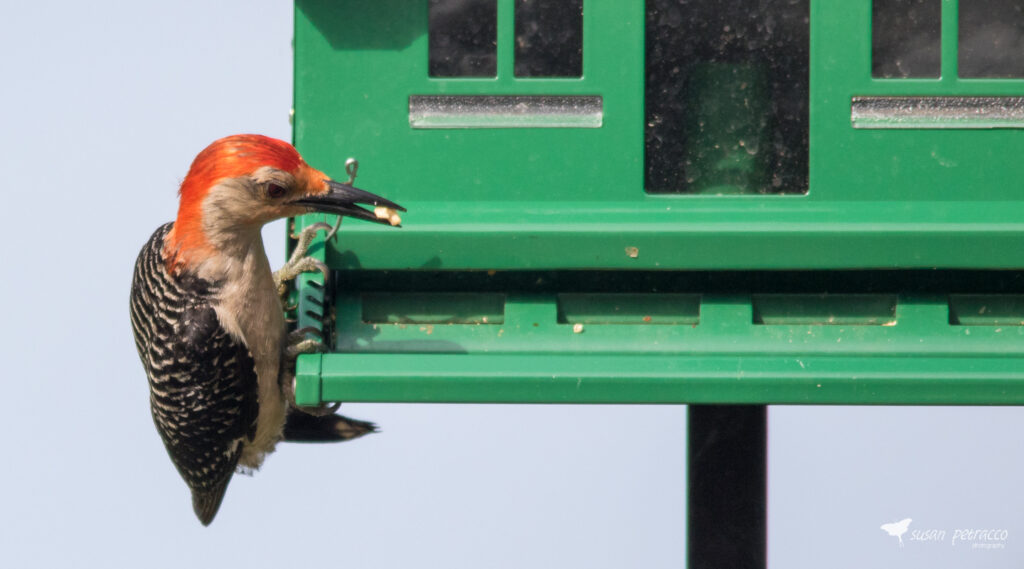
Squirrel-proof feeders have mechanisms to prevent squirrels from accessing the bird feed. These can help preserve your bird feed for its intended audience. (This is my favorite squirrel-proof feeder, one I have in my yard. You can see a Red-Bellied woodpecker eating out of it, above.)
The choice of feeder depends on the types of birds you want to attract and the seeds or food you plan to offer. To cater to a diverse range of avian visitors, consider incorporating a mix of these feeder types in your bird feeding station.
A bird feeder pole that can support multiple feeders will help you offer more diverse options in your yard. I particularly like the Advanced Pole System from Wild Birds Unlimited.
Bird Feed Options
Selecting the right bird feed is crucial for attracting specific bird species to your feeding station. Different birds have distinct dietary preferences, so offering a variety of foods can create a diverse avian haven in your yard. Here are some popular bird feed options to consider:
1. Black Oil Sunflower Seeds: These seeds are a favorite among many bird species, including cardinals, chickadees, finches, and sparrows. They have a high oil content, providing essential energy.
2. Nyjer (Thistle) Seed: Nyjer seeds are beloved by finches, siskins, and goldfinches. These tiny seeds require specialized tube feeders with small ports.
3. Safflower Seeds: Safflower seeds are ideal for deterring squirrels and attracting cardinals, chickadees, and grosbeaks. Many squirrels dislike the taste of safflower.
4. Millet: White proso millet is a versatile option that attracts sparrows, doves, and juncos. It can be scattered on platform feeders or used in various mixes.
5. Peanuts: Whole or shelled peanuts are popular with woodpeckers, Blue Jays, and nuthatches. Special peanut feeders are available for offering these treats.
6. Suet: Suet cakes provide high-energy fat and are favored by woodpeckers, wrens, and chickadees. They are especially valuable in cold weather.
7. Fruit: Fresh or dried fruit pieces can attract orioles, tanagers, and mockingbirds. Use fruit feeders or simply place fruit on platform feeders.
8. Mealworms: These live or dried insects are a protein-rich choice adored by bluebirds, robins, and warblers. Mealworm feeders can be used to offer them.
9. Hummingbird Nectar: A mixture of sugar and water (4 parts water to 1 part sugar) in nectar feeders will attract hummingbirds. Red coloring is not necessary and can be harmful to these birds.
10. Cracked Corn: Cracked corn can lure ground-feeding birds like sparrows, juncos, and doves. Scatter it on platform feeders or directly on the ground.
To maximize the variety of birds visiting your feeding station, experiment with different seed and food types. Keep in mind that providing fresh, high-quality food is essential for maintaining a healthy bird population in your backyard. In the following sections, we’ll explore the importance of water sources and how landscaping can further enhance your bird-friendly environment.
You can order bird food on Amazon, get it from big-box stores like Lowe’s and Home Depot, from Tractor Supply and other farm supply stores, or from specialty stores like Wild Birds Unlimited. Some bird seed quality is better than others.
Water Sources
Providing a reliable water source can significantly enhance the appeal of your bird feeding station. Water is essential for birds, not only for drinking but also for bathing. I live on a retention pond, so my backyard birds already have a water option and haven’t really used any I have tried. If you don’t have a water source nearby, consider adding one. Here are some options:
Bird Baths
Bird baths come in various sizes and designs. Opt for shallow basins with textured surfaces to give birds a secure grip. Place them near your feeding station, ensuring a constant supply of clean water.
In colder climates, a heated bird bath will prevent water from freezing during the winter months, ensuring birds have access to water year-round.
Regularly clean and refill your bird baths to prevent the buildup of algae and disease. Fresh, clean water is essential for the health of visiting birds.
Misting or Drippers
Installing misters or drippers can create moving water, which is particularly attractive to birds. The sound and motion of flowing water can draw more visitors to your yard.
Landscaping for Birds
Landscaping your yard with birds in mind can enhance their experience and make your backyard even more attractive. Here are some landscaping ideas.
Native Plants
Incorporate native plants into your landscape, as they provide natural food sources and shelter for local bird species. Research which plants are native to your region.
Bird-Friendly Trees and Shrubs
Trees and shrubs with berries, seeds, or nectar-producing flowers can attract a variety of birds. Examples include dogwoods, serviceberries, and native sunflowers. Plants that attract insects will in turn attract birds that eat insects, so don’t shy away from pollinator-friendly plants! (Click here to learn how to overcome your fear of bees!)
Create Habitat Diversity
Birds thrive in diverse environments. Plant a mix of tall trees, shrubs, and ground cover to create different layers of vegetation for birds to explore.
Leave Natural Debris
Allow fallen leaves, branches, and other natural debris to accumulate in some areas. Birds use these materials for building nests.
You may also consider reducing your use of pesticides in your yard. Pesticides kill the insects that many birds rely on for food. Additionally, rat poison makes its way into the food chain and can kill the birds that eat poisoned rodents, particularly owls.
Tips for Maintenance
A well-maintained bird feeding station ensures a continuous stream of avian visitors. Here are some tips to keep your station in optimal condition:
1. Regular Cleaning: Clean feeders and bird baths at least once a month, or more frequently if they become soiled. Use a mild bleach solution (1 part bleach to 9 parts water) for sanitization.
2. Seed Storage: Store bird seed in a cool, dry place to prevent it from spoiling or attracting pests. Use airtight containers to keep it fresh.
3. Monitor for Disease: Keep an eye out for sick birds, as bird feeding stations can sometimes contribute to disease transmission. If you observe sick birds, temporarily remove feeders to prevent the spread of illness.
4. Keep it Stocked: Ensure feeders are regularly filled, especially during the winter months when natural food sources can be scarce.
5. Repair and Replace: Regularly inspect feeders for damage and replace worn-out or broken parts promptly.
6. Record Observations: Keep a journal of the bird species you see at your feeding station and note any interesting behaviors or patterns.
Attracting Specific Bird Species
Different birds have distinct preferences when it comes to food and habitat. Here are some tips for attracting specific bird species to your yard:
1. Hummingbirds: Hang red nectar feeders and plant tubular flowers like trumpet vine and bee balm.
2. Cardinals: Offer sunflower seeds and provide dense shrubs or trees for nesting and cover.
3. Goldfinches: Nyjer (thistle) seed and water sources are key to attracting these vibrant yellow birds.
4. Woodpeckers: Suet feeders and the presence of trees for foraging and nesting will draw woodpeckers.
5. Song Sparrows: Provide millet and shrubby vegetation for these ground-feeding sparrows.
6. Bluebirds: Install nesting boxes and offer mealworms to entice these beautiful cavity nesters.
Conclusion
Incorporating a bird feeding station into your backyard is a delightful way to connect with nature and invite a vibrant community of birds into your life. By choosing the right location, selecting appropriate feeders and food, offering water sources, and landscaping thoughtfully, you can create a haven that beckons a symphony of chirps and tweets. Whether you’re an avid birdwatcher or simply seeking a closer connection to the natural world, your backyard can become a sanctuary where beauty takes flight right outside your window. Welcome to the world of backyard bird feeding stations!
